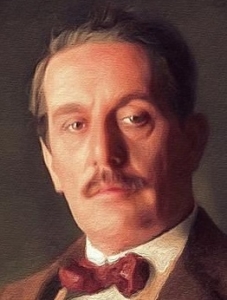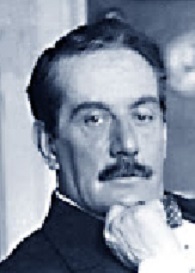Giacomo Puccini
Giacomo Puccini (22 December 1858 – 29 November 1924) was an Italian composer known primarily for his great operas.
Regarded as the greatest and most successful proponent of Italian opera after Verdi, he was descended from a long line of composers.
Though his early work was firmly rooted in traditional late-19th-century Romantic Italian opera he later developed his work in the realistic verismo style, of which he became one of the leading exponents.
 His most renowned works are La bohème (1896), Tosca (1900), Madama Butterfly (1904), and Turandot (1924), all of which are among the most frequently performed and recorded of all operas.
His most renowned works are La bohème (1896), Tosca (1900), Madama Butterfly (1904), and Turandot (1924), all of which are among the most frequently performed and recorded of all operas.
He wrote 16 operas, most of which are performed very often today. Many of his operatic songs are known by many people, especially the aria Nessun Dorma from Turandot.
Puccini was born in Lucca. He was expected to follow the family tradition and become a church organist. He started playing the organ in churches near Lucca.
He liked to improvise on the organ, playing popular tunes from Verdi’s operas.
He soon realized that he wanted to be an opera composer. Eventually, he persuaded his family to let him study at the Milan Conservatory.
His earliest compositions showed that he had a great talent for writing beautiful melodies and that he was good at writing for the orchestra.
Manon Lescaut was the first opera for which Puccini chose the story himself. It is the same story as Massenet’s opera Manon.
This made Puccini internationally famous. His next opera, La bohème, produced in 1896, is often thought to be his best opera.
 He worked with two poets on this opera and, although they quarreled a lot, the result was a work in which the music flowed beautifully like a conversation.
He worked with two poets on this opera and, although they quarreled a lot, the result was a work in which the music flowed beautifully like a conversation.
His next opera was Tosca. When it was first performed in Rome in 1900 there were rumors that a bomb would be thrown, but nothing happened.
Tosca was a great success. However, Madama Butterfly was hissed and booed at its first performance in Milan’s famous opera house La Scala in 1904.
It was at this time that Puccini married. He already had a son with Elvira, his wife, who had been married to someone else.
When her husband died, she was able to marry Puccini. The marriage was not without difficulties.
Elvira accused Puccini of having an affair with their servant girl. This servant girl committed suicide and there was a court case that resulted (after an autopsy) in Elvira being found innocent.
Puccini was very upset by all this and did not compose much for several years.
When he finally started writing again his new opera La fanciulla del West was set in the American West at the time of the Goldrush.
The music has very Impressionistic harmonies like that of Debussy. The way he writes for the orchestra shows the influence of Richard Strauss.
The opera was first performed in New York. The world-famous tenor Enrico Caruso sang the main hero part and Arturo Toscanini was the conductor. With such a star cast it had to be a great success.
Puccini followed this by writing an operetta and two one-act operas. The best of these is Gianni Schicchi.
His last opera is Turandot, which has a fairy-tale-like story. While he was working very hard at it he developed throat cancer.
He died of complications of the disease in autumn of 1924 in Brussels. The whole of Italy went into mourning and Mussolini spoke at the funeral.
Puccini had not quite managed to finish Turandot. A man called Franco Alfano finished it using the sketches that Puccini had left.
–
La bohème
La bohème is an opera in four acts, composed between 1893 and 1895 to an Italian libretto by Luigi Illica and Giuseppe Giacosa, based on Scènes de la vie de bohème (1851) by Henri Murger.
The story is set in Paris around 1830 and shows the Bohemian lifestyle (known in French as “La Bohème”) of a poor seamstress and her artist friends.
The world premiere of La Bohème was in Turin on 1 February 1896 at the Teatro Regio, conducted by the 28-year-old Arturo Toscanini.
Since then, La Bohème has become part of the standard Italian opera repertory and is one of the most frequently performed operas worldwide.
“Che gelida manina” (“What a frozen little hand”) is a tenor aria from the first act. The aria is sung by Rodolfo to Mimì when they first meet. In the aria, he tells her of his life as a poet and ends by asking her to tell him more about her life. It is one of the most recorded arias by tenors.
In this video, the aria is sung by Luciano Pavarotti at a performance in San Francisco.
Here is another video presenting a performance by Placido Domingo.
“Sì, mi chiamano Mimì” (“Yes, they call me Mimì”), is a soprano aria in which Mimi describes her simple life as an embroiderer.
In the video, the aria is sung by Asmik Grigorian at a festival in Vilnius in 2019.
Here is an older video presenting a performance by Maria Callas.
“O soave fanciulla” (“Oh gentle maiden”) is a romantic duet that is sung as the closing number in act 1 by Rodolfo (tenor) and Mimì (soprano).
In the video, the aria is sung by Anna Netrebko and Rolando Villazón.
Here is another video performance by Nicole Car and Michael Fabiano at the Royal Opera.
“O Mimì, tu più non torni?” (“O Mimì, will you not return?”) is an aria from Act IV. In their Parisian garret, Rodolfo and Marcello try but fail to work. They pretend to be indifferent about their lovers having left them for wealthy men, but their true feelings soon rise to the surface.
In the video, the aria is sung by Plácido Domingo and Luciano Pavarotti.
–
La fanciulla del West
La fanciulla del West (The Girl of the West) is an opera in three acts to an Italian libretto by Guelfo Civinini and Carlo Zangarini, based on the 1905 play The Girl of the Golden West by the American author David Belasco.
Fanciulla followed Madama Butterfly, which was also based on a Belasco play.
The opera has fewer of the show-stopping highlights that characterize Puccini’s other works but is admired for its impressive orchestration and for a score that is more melodically integrated than is typical of his previous work.
The opera had a successful and highly publicized premiere at the Metropolitan Opera, New York City, in 1910.
Nevertheless, while Puccini deemed it one of his greatest works, La fanciulla del West has become a less popular opera within the composer’s repertoire, drawing a mixed public reception overall.
“Ch’ella mi creda” (“let her believe”) is a tenor aria from act 3. It is sung by Dick Johnson (a.k.a. the bandit “Ramerrez”) before he is to be executed by a lynch mob of gold prospectors.
In the aria, Johnson asks them not to tell Minnie, whom he loves, that he has been killed. Instead, he asks them to “let her believe” that he is far away, on the road to redemption from his bandit past.
In the video, the aria is sung by Placido Domingo in a recording from 1996 in Tokyo, Japan
Here is a video performance of the area by Luciano Pavarotti.
This video presents another fine performance of the aria by Giuseppe Giacomini.
–
Suor Angelica
Suor Angelica (Sister Angelica) is an opera in one act to an original Italian libretto by Giovacchino Forzano. It is the second opera of the trio of operas known as Il trittico (The Triptych).
It received its world premiere at the Metropolitan Opera on December 14, 1918.
The opera chronicles the fall, redemption, and final transfiguration of its central character, Sister Angelica, who has taken the veil in repentance for bearing a child out of wedlock.
It contains one of the most beautiful arias Puccini ever wrote for a soprano voice, «Senza mamma», in which Angelica describes the sorrow of not being there for her son when he died.
“Senza Mamma” (“Without your Mother”) is the aria sung in the opera by Sister Angelica. She describes the sorrow of not being there for her son when he died. It is one of the most poignant moments in any of Puccini’s works and has remained a repertoire favorite.
In the video, the area is sung by Renata Scotto.
Here is another video performance by Kiri Te Kanawa.
–
Tosca
Tosca is an opera in three acts to an Italian libretto by Luigi Illica and Giuseppe Giacosa. It premiered at the Teatro Costanzi in Rome on 14 January 1900.
The work, based on Victorien Sardou’s 1887 French-language dramatic play, La Tosca, is a melodramatic piece set in Rome in June 1800, with the Kingdom of Naples’s control of Rome threatened by Napoleon’s invasion of Italy.
It contains depictions of torture, murder, and suicide, as well as some of Puccini’s best-known lyrical arias.
“Recondita armonia” (“Recondite harmony”) ia an aria sung by Cavaradossi who is Tosca’s lover. He is painting a Madonna for the church and he has based the painting on a woman who prays often at the church.
He sings of the differences between his picture of a fair Madonna and the darker beauty of his love, Tosca.
In the video, the aria is sung by Placido Domingo.
Here is another video performance by Luciano Pavarotti at the Metropolitan Opera.
–
Gianni Schicchi
Gianni Schicchi is a comic opera in one act to an Italian libretto by Giovacchino Forzano, composed in 1917–18. The libretto is based on an incident mentioned in Dante’s Divine Comedy. The work is the third and final part of Puccini’s Il trittico (The Triptych) – three one-act operas with contrasting themes, originally written to be presented together. However, Gianni Schicchi is now more frequently staged either alone or with short operas by other composers.
“O mio babbino caro” (“Oh my dear papa”) is a soprano aria sung by Lauretta after tensions between her father Schicchi and the family of Rinuccio, the boy she loves, have reached a breaking point that threatens to separate her from Rinuccio. It provides an interlude expressing lyrical simplicity and love.
The aria is frequently performed in concerts and as an encore in recitals by many popular and crossover singers.
In the video, the aria is sung by Anna Netrebko.
Here is another video performance by the legendary Maria Callas.
–
Madama Butterfly
Madama Butterfly is an opera in three acts with an Italian libretto by Luigi Illica and Giuseppe Giacosa.
The original version of the opera, in two acts, had its premiere on 17 February 1904 at La Scala in Milan. It was poorly received. This was due in part to a late completion by Puccini, which gave inadequate time for rehearsals.
Puccini revised the opera, splitting the second act in two, with the Humming Chorus as a bridge to what became Act III, and making other changes. Success ensued, starting with the first performance on 28 May 1904 in Brescia.
“Un bel dì, vedremo” (“One fine day we’ll see”) is a soprano aria sung by Cio-Cio San (Butterfly) as she imagines the return of her absent love, Pinkerton.
It is the most famous aria in Madama Butterfly, and one of the most popular pieces in the entire soprano repertoire.
In the video, the aria is sung by Anna Netrebko.
Here is another video performance by Angela Gheorghiu.
Finally, this video shows a performance by Asmik Grigorian.
Coro a bocca chiusa (“Humming Chorus”). As the off-stage chorus hums a wordless, melancholy tune, Butterfly, her child and Suzuki begin the long wait for Pinkerton to come. Night falls. Suzuki and the baby are soon asleep, but Butterfly keeps her vigil.
The video presents a performance by the Hamburg Radio Symphony Orchestra and the Chorus of The Theatro Nuovo di Milano.
This video presents a live performance from Madrid of the humming chorus.
–
Turandot
Turandot is an opera in three acts by Puccini, posthumously completed by Franco Alfano in 1926, and set to a libretto in Italian by Giuseppe Adami and Renato Simoni.
“Signore, ascolta!” (“My lord, listen!”) is a soprano aria in act one of the opera. The Italian lyrics were written by Giuseppe Adami and Renato Simoni.
It is sung by Liù (a slave girl) to Prince Calaf, whom she is secretly in love with. Liù sings this aria begging Calaf not to risk his life for his love to a beautiful but cold Princess Turandot, who set a condition that any man who wishes to marry her must first answer her three riddles, and if he fails, he will be beheaded.
In the video, the aria is sung by Anna Netrebko.
In this video, the aria is sung by Maria Callas.
“Nessun Dorma” (“Let no one sleep”) is an aria from the final act and one of the best-known tenor arias in all opera.
It is sung by Calaf, il principe ignoto (the unknown prince), who falls in love at first sight with the beautiful but cold Princess Turandot. In the aria, Calaf expresses his triumphant assurance that he will win the princess.
In the video, the aria is sung by Placido Domingo.
In this video, the aria is performed by The Three Tenors in Concert 1994.
–


